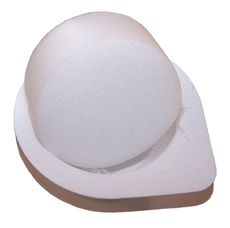避孕海綿
| A+醫學百科 >> 避孕海綿 |
| 避孕海綿 | |
|---|---|
 Protectaid牌的避孕海綿,放置在塑膠托盤上,在使用前要從托盤上取下 |
|
| 背景 | |
| 生育控制種類 | 屏障性 |
| 初次使用日期 | 1983 |
| 失效比率 (第一年) | |
| 完美使用 | 無生產經驗:9%[1] 已有生產經驗:20[1]% |
| 一般使用 | 無生產經驗:12%[1] 已有生產經驗:24[1]% |
| 用法 | |
| 可逆性 | 立即 |
| 注意事項 | ? |
| 優點及缺點 | |
| 是否可以防止性傳播疾病 | 否 |
| 好處 | 可在性交前12至24小時使用 |
| 風險 | 念珠菌症、偶爾會出現中毒性休克症候群 |
避孕海綿是一種合併了屏障法及殺精劑的避孕裝置,使用方式類似衛生棉條,於性交前塞入陰道中,並且將其蓋住子宮頸,以拒絕精子進入子宮;避孕海綿中含有殺精劑,可以避免精子移動[2]。其避孕效果不如口服避孕藥或者子宮內避孕器[3],而且無法防止性傳染疾病的傳播。
避孕海綿在市面上包括三個品牌:Pharmatex、Protectaid及Today。Pharmatex在法國及加拿大魁北克省販售,Protectaid在加拿大其他地區及歐洲販售,Today則在美國販售[4]。
目錄 |
效果
Today牌避孕海綿的製造商認為若正確且持續的使用,其避孕效果可到89%至91%,若沒有在每次性交時都依指示正確使用,避孕效果約有84%至89%[5]。其他資料來源則有已生產過婦女的數據,正確使用時避孕效果約有74%,一般使用則約有68%[6]。
Protectaid牌避孕海綿的研究結果指出其避孕效果約有77%至91%[7][8]。
Pharmatex牌避孕海綿的研究結果發現若正確使用,其避孕效果可達每年99%[9],一般使用的避孕效果約有每年81%[10]。 避孕海綿可以和其他避孕方式(如保險套)一起使用,以提高避孕效果。
用法
若要使用Today牌的避孕海綿,需在完全濕潤的條件下穿載,約需加入兩湯匙的水[5]。水是作為海綿內殺精劑活化的機制[11],不需額外加入殺精劑[11]。另外二個牌子則是開封后即可使用[4][10]。
海綿可以在性交前24小時放入體內,性交後需在置於體內六小時以上,在體內的時間不得超過30小時。
使用過的避孕海綿若已從陰道中取出,不可再重複使用[11]。
歷史
自從引進之後,避孕海綿有一段時間在特定地區是無法取得的。現在藉著網路購物,在其正常的銷售地區外也可以買到。
Today牌
Today牌的避孕海綿在1976年開發,在1983年引進美國,在1994年後一度退出美國市場,後在2003年3月在加拿大重新販售,在2005年9月在美國重新販售。2007年製造商破產,產生一度下架,後來在2009年又重新上市。
Pharmatex牌
Pharmatex牌的避孕海綿在1984年引進法國及加拿大的魁北克[12]。
Protectaid牌
Protectaid牌的避孕海綿是在1996年引進加拿大,2000年引進歐洲[4]。
殺精劑
避孕海綿是物理性的屏障,不讓精子穿過子宮頸進入子宮。殺精劑也是一項重要的避孕方式的。各家用的殺精劑也有所不同。
Today牌的海綿含有1,000mg的壬苯醇醚-9[13], Protectaid牌的海綿含有5,000 mg的F-5凝膠,其中有三種有效成份(6.25 mg 的壬苯醇醚-9,6.25 mg[[苯扎氯銨]]及25 mg的[[膽酸鈉]])[10],Pharmatex牌的海綿則含有60 mg的苯扎氯銨[4]。
副作用
有些人會對避孕海綿中的殺精劑過敏。女性使用避孕海綿會增加念珠菌症及尿道感染的風險。不正確的使用(如留在體內太久)可能會造成中毒性休克症候群。
Today牌的海綿含有殺精劑壬苯醇醚-9,會刺激組織,對於一天使用數次的人,或是可能有HIV的人而言,可能會增加HIV或其他性傳染疾病的風險[2]。
參考資料
- ↑ 1.0 1.1 1.2 1.3 Trussell, James. Contraceptive efficacy//Hatcher, Robert A.; Trussell, James; Nelson, Anita L. .. Contraceptive technology. 20th revised. New York: Ardent Media. 2011: pp. 779–863. ISBN 978-1-59708-004-0. ISSN 0091-9721. OCLC 781956734. Table 26–1 = Table 3–2 Percentage of women experiencing an unintended pregnancy during the first year of typical use and the first year of perfect use of contraception, and the percentage continuing use at the end of the first year. United States.
- ↑ 2.0 2.1 Bith Control Sponge Planned Parenthood. (2011). Retrieved February 3, 2010.
- ↑ 避孕海綿 台灣也買得到. 自由時報 [2014-03-17].
- ↑ 4.0 4.1 4.2 4.3 Sponges. Cervical Barrier Advancement Society [2006-09-17].
- ↑ 5.0 5.1 How Well Does Today Sponge Prevent Pregnancy?. Today Sponge. Allendale Pharmaceuticals [2006-08-17] (原始內容存檔於2006-07-17).
- ↑ Hatcher, RA; Trussel J, Stewart F, et al.. Contraceptive Technology. 18th. New York: Ardent Media. 2000. ISBN 0-9664902-6-6.
- ↑ Creatsas G, Elsheikh A, Colin P. Safety and tolerability of the new contraceptive sponge Protectaid. Eur J Contracept Reprod Health Care. 2002, 7 (2): 91–5. doi:10.1080/713604323. PMID 12201327.
- ↑ Creatsas G, Guerrero E, Guilbert E, Drouin J, Serfaty D, Lemieux L, Suissa S, Colin P. A multinational evaluation of the efficacy, safety and acceptability of the Protectaid contraceptive sponge. Eur J Contracept Reprod Health Care. 2001, 6 (3): 172–82. doi:10.1080/713604234. PMID 11763982.
- ↑ Ovule Pharmatex: results of 10 years of research in contraception. Nurs Que. 1983, 3 (2): 33. PMID 6552435.
Serfaty D. The contraceptive sponge. Entret Bichat Pitie Salpetriere Ther. 1982: 225–8. PMID 12340222.
Leroy B, Serror R. Contraception through the use of intravaginal spermicides during the post-partum period. Rev Fr Gynecol Obstet. 1979, 74 (1): 63–5. PMID 424660. - ↑ 10.0 10.1 10.2 The Birth Control Sponge. Global Health Options [2006-10-06].[失效连结]
- ↑ 11.0 11.1 11.2 Mayo Clinic. (2010). Retrieved February 3, 2011
- ↑ Menard F. The health of women and contraception in Quebec. IPPF Eur Reg Inf. 1984, 13 (1): 18–20. PMID 12178356.
- ↑ Best, Kim. New Devices May Be Easier to Use. Network. Family Health International. 2000, 20 (2) [2006-10-01].
|
|||||||||||||||||||||||||||||||||||||
參考來源
| 關於「避孕海綿」的留言: | |
|
目前暫無留言 | |
| 添加留言 | |